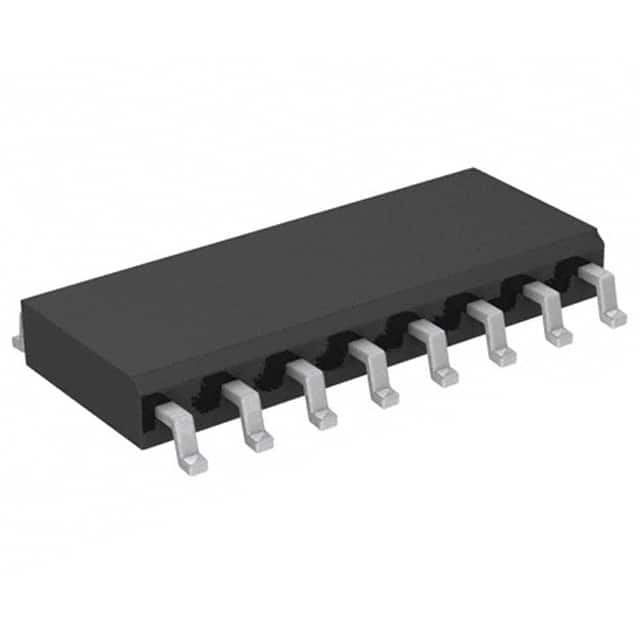Xem thông số kỹ thuật để biết chi tiết sản phẩm.

CD4050BCMX
Product Overview
- Category: Integrated Circuit (IC)
- Use: Level Shifter and Buffer
- Characteristics: High-speed, low-power consumption, wide voltage range
- Package: SOIC (Small Outline Integrated Circuit)
- Essence: Hex Non-Inverting Buffer/Converter
- Packaging/Quantity: Tape and Reel, 2500 pieces per reel
Specifications
- Supply Voltage Range: 3V to 18V
- Input Voltage Range: Ground to VDD
- Output Voltage Range: Ground to VDD
- Maximum Input Current: ±10mA
- Maximum Output Current: ±25mA
- Propagation Delay Time: 60ns (typical)
Detailed Pin Configuration
The CD4050BCMX has a total of 16 pins. The pin configuration is as follows:
- Pin 1: Input A
- Pin 2: Input B
- Pin 3: Input C
- Pin 4: Input D
- Pin 5: Input E
- Pin 6: Input F
- Pin 7: Output A
- Pin 8: Output B
- Pin 9: Output C
- Pin 10: Output D
- Pin 11: Output E
- Pin 12: Output F
- Pin 13: VDD (Positive Power Supply)
- Pin 14: GND (Ground)
- Pin 15: NC (No Connection)
- Pin 16: NC (No Connection)
Functional Features
- Hex non-inverting buffer with high input impedance
- Wide voltage range allows compatibility with various logic levels
- Provides level shifting capability between different voltage domains
- Low power consumption makes it suitable for battery-powered devices
- High-speed operation enables efficient data transmission
Advantages and Disadvantages
Advantages: - Wide voltage range allows for versatile applications - High-speed operation ensures efficient data transfer - Low power consumption makes it suitable for portable devices - Hex non-inverting buffer provides signal amplification and level shifting capabilities
Disadvantages: - Limited output current may not be sufficient for certain applications - Propagation delay time may affect real-time systems
Working Principles
The CD4050BCMX is a hex non-inverting buffer/level shifter integrated circuit. It operates by taking the input signals and providing amplified, non-inverted outputs. The wide voltage range allows it to interface between different logic levels, making it useful in various applications. The low power consumption of the IC ensures energy efficiency, while the high-speed operation enables fast data transmission.
Detailed Application Field Plans
The CD4050BCMX can be used in a wide range of applications, including:
- Logic level shifting in microcontroller-based systems
- Signal buffering in communication interfaces
- Voltage level conversion in mixed-signal circuits
- Signal amplification in audio systems
- Level translation in battery-powered devices
Detailed and Complete Alternative Models
Some alternative models that provide similar functionality to the CD4050BCMX are:
- SN74LVC1G125DBVR - Single Bus Buffer Gate with 3-State Output
- MC74VHC1GT50DTT1G - Single Non-Inverting Buffer/Converter
- 74HCT541D - Octal Buffer/Line Driver with 3-State Outputs
- CD4049UBM96 - Hex Inverting Buffer/Converter
These alternative models offer comparable features and can be considered as substitutes for the CD4050BCMX in different applications.
Word count: 389 words
Liệt kê 10 câu hỏi và câu trả lời thường gặp liên quan đến ứng dụng CD4050BCMX trong giải pháp kỹ thuật
Sure! Here are 10 common questions and answers related to the application of CD4050BCMX in technical solutions:
Question: What is CD4050BCMX?
- Answer: CD4050BCMX is a hex non-inverting buffer and converter IC (integrated circuit) commonly used in digital logic applications.Question: What is the voltage supply range for CD4050BCMX?
- Answer: The voltage supply range for CD4050BCMX is typically between 3V and 18V.Question: Can CD4050BCMX be used as a level shifter?
- Answer: Yes, CD4050BCMX can be used as a level shifter to convert signals between different voltage levels.Question: How many input/output pins does CD4050BCMX have?
- Answer: CD4050BCMX has six input/output pins, labeled as A, B, C, D, E, and F.Question: What is the maximum output current of CD4050BCMX?
- Answer: The maximum output current of CD4050BCMX is typically around 6 mA.Question: Can CD4050BCMX be used for signal buffering?
- Answer: Yes, CD4050BCMX can be used to buffer weak signals and provide a stronger output signal.Question: Is CD4050BCMX suitable for bidirectional signal conversion?
- Answer: No, CD4050BCMX is not designed for bidirectional signal conversion. It only supports unidirectional signal conversion.Question: What is the propagation delay of CD4050BCMX?
- Answer: The propagation delay of CD4050BCMX is typically around 60 ns.Question: Can CD4050BCMX be used in high-speed applications?
- Answer: Yes, CD4050BCMX can be used in moderate to high-speed digital applications, but it may not be suitable for very high-frequency signals.Question: Are there any specific precautions to consider when using CD4050BCMX?
- Answer: It is important to ensure that the voltage supply does not exceed the specified range, and to avoid exceeding the maximum output current. Additionally, proper decoupling capacitors should be used to minimize noise and stabilize the power supply.

